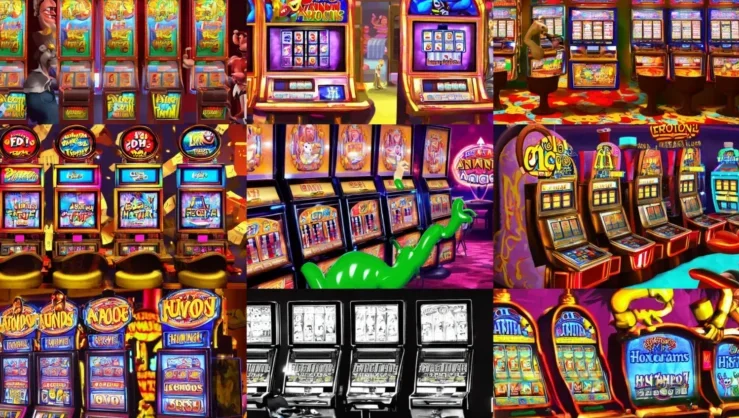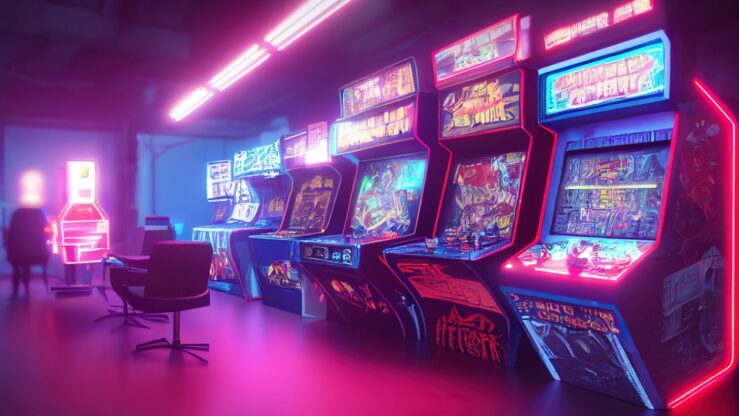Slot machines, often referred to as “one-armed bandits,” have evolved from simple mechanical devices into complex multimedia experiences that are prevalent in both physical casinos and online gambling platforms. They have captured the attention of millions of players worldwide and are an integral part of the modern gambling industry. Beyond the excitement of potentially hitting the jackpot, slot machines offer a unique form of entertainment that blends art and design in a way that’s unlike any other.
In this blog, we’ll explore the fascinating world of slot machine aesthetics, delving into the art and design aspects that make these games so captivating. We’ll look at the history of slot machines, how technology has transformed them, and the role of aesthetics in their popularity.
The Evolution of Slot Machines
To understand the aesthetics of slot online gacor machines, it’s essential to grasp their evolution over time. Slot machines have a rich history dating back to the late 19th century when the first mechanical slot machine was invented by Charles Fey in 1895. This early version featured three spinning reels with five symbols, including horseshoes, diamonds, spades, hearts, and a Liberty Bell, which gave the machine its name.
Early slot machines were relatively simple in design, focusing on functionality rather than aesthetics. They featured basic graphics and limited themes, often showcasing traditional symbols such as fruits, bars, and sevens. However, as technology advanced, so did the visual appeal of these games.
The Influence of Technology
The introduction of electricity and microprocessors revolutionized slot machines. This technological leap allowed for the incorporation of more intricate designs, animated graphics, and sound effects. Slot machines evolved from mechanical contraptions to electronic wonders, offering players a more immersive experience.
Video slots, which emerged in the 1970s, marked a significant turning point in the aesthetics of slot machines. These machines replaced physical reels with high-resolution video screens, paving the way for a new era of creative possibilities. Game developers could now craft visually stunning and thematically diverse games that catered to a broader audience.
Themes and Storytelling

Aesthetics play a crucial role in the thematic elements of slot machines. Today’s slots feature a wide array of themes, ranging from ancient civilizations and mythical creatures to popular movies and TV shows. The visual design of these games transports players to different worlds and tells engaging stories, making the experience more than just a gamble.
For example, a slot machine based on ancient Egypt might feature pharaohs, pyramids, and hieroglyphs in its design, while a slot inspired by a blockbuster movie could incorporate iconic characters and scenes. The aesthetics not only make the game visually appealing but also create a sense of immersion, drawing players into the narrative.
Graphics and Animation
The graphics and animation in modern slot machines are nothing short of remarkable. High-definition visuals, intricate details, and smooth animations captivate players and hold their attention. These games often feature 3D graphics, creating a sense of depth and realism that was unimaginable in the early days of slot machines.
The animations in slot machines are not merely eye candy; they serve a functional purpose. When a player wins, the symbols often come to life with dynamic animations, enhancing the excitement of the moment. Similarly, bonus rounds and special features are presented through visually stunning animations that provide an engaging and entertaining experience.
Sound Design

Aesthetics in slot machines extend beyond visuals to encompass sound design. Sound plays a critical role in creating a complete sensory experience for players. The use of music, jingles, and sound effects enhances the gameplay and immerses players in the slot’s theme.
For instance, a slot machine set in a tropical paradise might feature the sounds of ocean waves and seagulls, while a horror-themed slot could use eerie music and spine-tingling sounds. The auditory cues heighten the emotional connection players have with the game, influencing their overall enjoyment and engagement.
Color Psychology
Color is a fundamental aspect of aesthetics in slot machine design. Game developers carefully select color schemes to evoke specific emotions and reactions in players. Different colors are associated with varying moods and feelings, and this knowledge is leveraged in slot design.
For example, vibrant and warm colors like red and gold are often used in slots to convey excitement and luxury, while blue and green tones might be employed to create a calm and relaxing atmosphere. The use of color psychology in slot design enhances the player’s experience and influences their perception of the game.
Player Engagement and Retention

Slot machine aesthetics are not just about catching a player’s initial attention; they also play a crucial role in player engagement and retention. Games that are visually appealing and feature innovative designs are more likely to keep players coming back for more. Engaging aesthetics create a sense of excitement and anticipation, making the gameplay experience more enjoyable.
Incorporating Gamification
Recent developments in the gambling industry have seen the integration of gamification elements into slot machines. Gamification refers to the use of game-like features such as levels, achievements, and interactive narratives to enhance the overall gaming experience. Slot machines with gamification elements take aesthetics to a new level.
Players can embark on quests, unlock achievements, and progress through storylines, all while enjoying the traditional slot gameplay. This blurs the lines between gambling and gaming, offering a unique and immersive experience that keeps players engaged for longer periods.
Artistic Collaboration

The aesthetics of slot machines often involve collaborations with talented artists and designers. Game developers work closely with graphic artists, animators, and sound engineers to create visually stunning and immersive experiences. This collaboration between art and technology is what sets modern slot machines apart.
Artists are responsible for bringing the game’s theme to life through stunning visuals. Their work includes designing symbols, backgrounds, and character animations. The result is a harmonious blend of art and technology that appeals to both artistic sensibilities and the desire for entertainment.
Cultural and Pop-Culture References
Slot machine aesthetics often draw inspiration from cultural and pop-culture references. This approach not only caters to a broad audience but also taps into the nostalgia and interests of players. Games that feature beloved icons, historical references, or elements from popular culture can be particularly appealing.
For example, a slot machine with a music theme might incorporate iconic album covers and musical instruments, while a slot based on a famous TV show could include recognizable characters and quotes. These references add a layer of familiarity and excitement to the gameplay, further enhancing the overall aesthetics.
Regulatory and Ethical Considerations
While the aesthetics of slot machines are undoubtedly captivating, they are not without their controversies. Some argue that the visually appealing and immersive nature of these games can be problematic, as they may encourage excessive gambling. As a result, there have been calls for increased regulation and responsible gaming measures in the industry.
To address these concerns, some jurisdictions have imposed restrictions on the design and marketing of slot machines. This includes limits on the use of certain graphics and themes that may appeal to vulnerable individuals. While these regulations aim to protect players, they also raise questions about the fine line between art and responsible gambling.
Conclusion
The aesthetics of slot machines are a testament to the ever-evolving marriage of art and technology. From their humble mechanical beginnings to the complex, multimedia experiences of today, slot machines have come a long way. They are a fusion of graphic design, animation, sound, color psychology, and storytelling, all working together to create an enticing and immersive gaming experience.
While the aesthetics of slot machines are undoubtedly captivating, it’s essential to remember that these games are not just about visual appeal; they also carry ethical and regulatory responsibilities. Striking a balance between the art and design elements that make slot machines so engaging and the need for responsible gaming is an ongoing challenge for the industry.
In the end, the slot machine aesthetics continue to evolve, pushing the boundaries of what is possible in the world of gaming and entertainment. As technology advances and player expectations change, one thing is clear: the art and design of slot machines will continue to play a central role in the gambling industry, shaping the experiences of millions of players worldwide.

